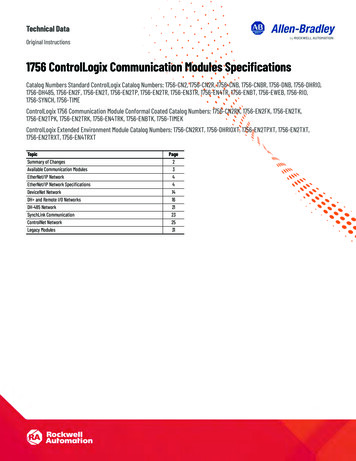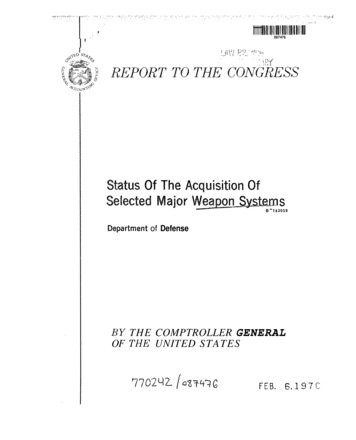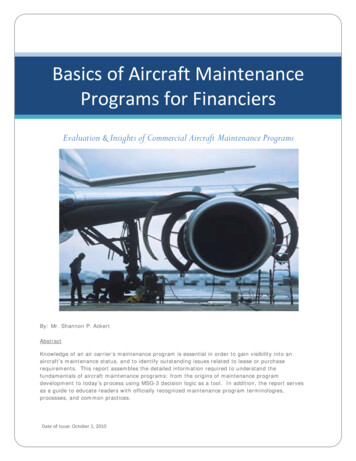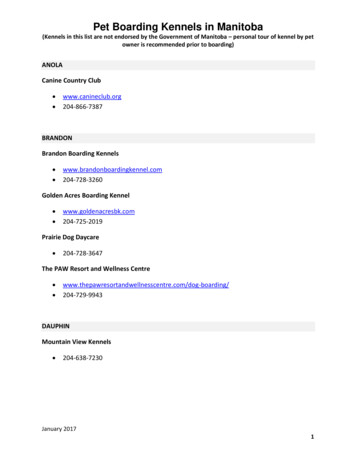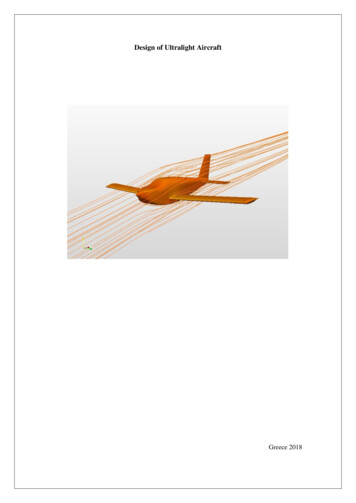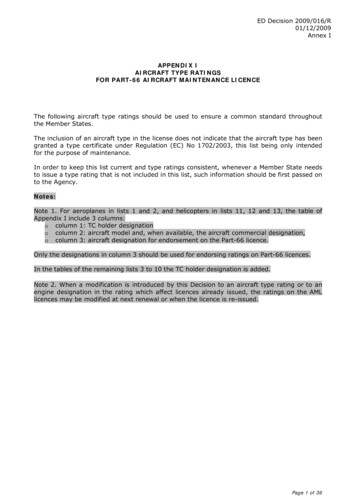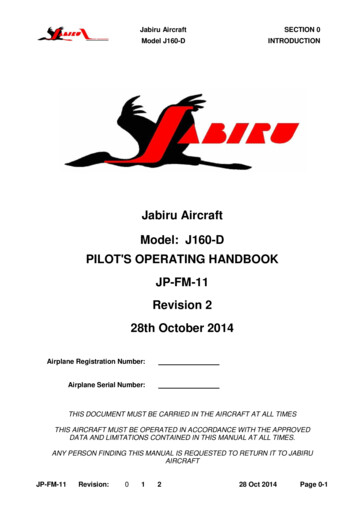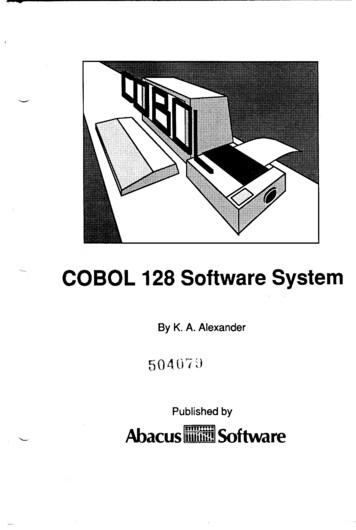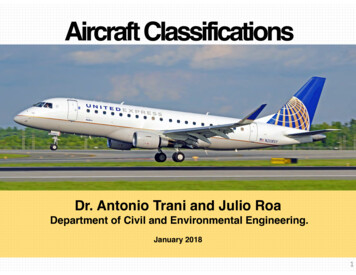
Transcription
Aircraft ClassificationsDr. Antonio Trani and Julio RoaDepartment of Civil and Environmental Engineering.January 20181
Material PresentedThe aircraft and the airportAircraft classificationsAircraft characteristics and their relationto airport planningLarge capacity aircraft impacts2
Relevance of AircraftCharacteristicsAircraft classifications are useful in airport engineeringwork (including terminal gate sizing, apron andtaxiway planning, etc.) and in air traffic analysesMost of the airport design standards are related toaircraft size (i.e., wingspan, aircraft length, aircraftwheelbase, aircraft seating capacity, etc.)Airport fleet compositions vary over time and thus isimperative that we learn how to forecast expectedvehicle sizes over long periods of timeThe Next Generation (NextGen) air transportationsystem will have to accommodate to a more diversepool of aircraft3
Airport Engineering and AircraftCharacteristicsImportant to know the performance aspects of the aircraft on theground (low taxiing speeds) as well as on takeoff and landingBoeing 737-800 Landing at Runway 36L in Charlotte (A.A.Trani)4
Web Sites to Learn to RecognizeVarious Aircraft Pictures taken by the author at various airport (https://photos.app.goo.gl/8bdSvdwPQU7lHIDi2) Airliners site airliners.net Jetphotos (https://www.jetphotos.com)Aerospatiale ATR-42-500Airbus A380-8005
ICAO - International Civil AviationOrganizationProvides guidance about airport design in all countries of the WorldFAA design standards and ICAO standards are trending to thesame values with timeICAO Documents 9157 - Aerodrome Design Manual6
ICAO Aerodrome Reference CodeCode Element 1ICAO Aerodrome Reference Code used in Airport DesignCode NumberAeroplane Reference Field Length(meters)1Less than 8002800 but less than 120031200 but less than 18004More than 18007
ICAO Aerodrome Reference CodeCode Element 2ICAO Aerodrome Reference Code used in Airport Geometric DesignDesignGroupWingspan(m)Outer MainLanding GearWidth (m)ExampleAircraftA 15 4.5All single engine aircraft,Some business jetsB15 to 244.5 to 6Commuter aircraft, large business jets(EMB - 120, Saab 2000, Saab 340, etc.)C24 to 366 to 9Medium-range transports(B727, B737, MD-80, A320)D36 to 529 to 14Heavy transports(B757, B767, MD-80, A300)E52 to 659 to 14Heavy transport aircraft(Boeing 747, A340, B777)F65 to 8014 to 16A380, Antonov 2258
Federal Aviation AdministrationRunway Design Code (RDC) Combines three classification criteria to define thedesign specifications of each runway of the airport: Aircraft Approach Code (AAC) Aircraft Design Group (ADG) Approach visibility minimums A fourth classification - called Taxiway Design Group(TDG) is also used in airport design The following slides provide some insight about eachclassification schemeNote: An airport may have different RDC standards for different runwaysFor example, a runway used for air carrier operations may use a higher RDC standardthan a runway used for General Aviation Operations9
Example: Baltimore-WashingtonInternational (BWI)Runway 33Used by General AviationaircraftRunway 28Used by air carrieraircraftsource: Google Earth10
Federal Aviation AdministrationAircraft Design Group (ADG)DesignGroupTail Height(feet)Wingspan(feet)RepresentativeAircraft TypesI 20 49Cessna 172, Beech 36,Cessna 421, Learjet 35II20 to 3049 to 79Beech B300, Cessna 550,Falcon 50, Challenger 605III30 to 4579 to 118Boeing 737, Airbus A320,CRJ-900, EMB-190IV45 to 60118 to 171Boeing 767, Boeing 757,Airbus A300, Douglas DC-10V60 to 66171 to 214Boeing 747, Airbus A340,Boeing 777VI66 to 80214 to 262Airbus A380, Antonov 225** The Antonov 225 has a wingspan of 290 feet (in a class by itself). Only one aircraft produced.11
Federal Aviation AdministrationAircraft Design Group (ADG)Note: Always use the most criticaldimension of the two criteria shownin Table 1-1source: Table 1-2 of FAA AC 150/5300-13A12
FAAAircraft Approach SpeedClassification (AAC)Airport Terminal Area Procedures Aircraft Classification (FAA Scheme)GroupApproach aSpeed (knots)ExampleAircraftbA 91All single engine aircraft,Beechcraft Baron 58B91 to 121Business jets and commuter aircraft (Beech 1900,Saab 2000, Saab 340, Embraer 120, Canadair RJ, etc.)C121 to 141Medium and short range transports(Boeing 727, B737, MD-80, A320, F100, B757, etc.)D141 to 166Heavy transports(Boeing 747, A340, B777, DC-10, A300)E 166BAC Concorde and military aircrafta. At maximum landing weightb. See Appendix 1 in FAA Advisory Circular 150/5300-13A for a complete listing ofaircraft approach speeds13
FAAAircraft Approach SpeedClassification (AAC)source: Table 1-1 of FAA AC 150/5300-13A Aircraft approach speeds are taken at maximumallowable landing weight For the same aircraft, approach speeds vary by weight For typical commercial aircraft, approach speeds canvary as much as 15-20 knots between maximum landingweight and empty operating weight)14
Example of Aircraft Approach SpeedVariations Consider the Airbus A340-500- a long-range aircraftApproach Speed (knots)Max. AllowableLanding Weight300,000 kg Approach speed at 180,000kg landing weight 125 knots Approach speed at 300,000kg landing weight (maximumallowable landing mass) 160 knotssource: Airbus A340-500 Airplane Characteristicsfor Airport Planning15
Source to Find Aircraft ApproachSpeed and Aircraft Mass (weight) DataFAA Advisory Circular AC/150 5300-13 Airport Design (Appendix I)““16
Presentation of Aircraft Characteristicsin Appendix I of AC 150/5300-13ATable A1-1. Aircraft characteristics database - sorted by aircraftmanufacturer modelAircraftApproach ClassAircraft DesignGroupTaxiway DesignGroup17
Approach Visibility MinimumsDefined by a parameter called Runway Visual Range (RVR)“RVR is the range over which the Pilot of an aircraft on the centre lineof a runway can see the runway surface markings or the lightsdelineating the runway or identifying its centre line.” (ICAO)RVR Equipment18
Approach Visibility Minimumssource: Table 1-3 of FAA AC 150/5300-13AInstrument Landing System Categories19
Recap: Runway Design Code (RDC)Three parameters are combined to derive a so-calledRunway Design Code (RDC)AAC, ADG and Approach Visibility MinimumsRDC provides three parameters needed to determinedesign standards for an airportNote: for most airport design projects the TDGparameter is also critical to determine taxiway-to-runwaydistances20
Taxiway Design Group (TDG)Previous FAA guidance considered tail height andwingspan as design factors for geometric designNew guidance implemented in September 2012considers:- Dimensions of the aircraft undercarriage- Main gear width (MGW)- Cockpit to main gear dimensions (CMG)21
FAAAC 150/5300-13AAppendix IFigure A1-1. Typical dimensions of large aircraft22
FAAAC 150/5300-13AAppendix IFigure A1-2. Typical dimensions of small aircraft23
CMG Distance vs WheelbaseDistanceFAA specifies:Cockpit to Main Gear (CMG) dimension will be usedinstead of the aircraft wheelbase for aircraft where thecockpit is located forward of the nose gear (typicallyapplies to commercial aircraft)For aircraft with the cockpit located aft of the nose gear,use the wheelbase instead of CMG to determine theTaxiway Design Group (TDG)See figures in the previous slides24
Examples : Small AircraftMany general aviation aircraft (called GA) typically have the nose gearlocated in front of the cockpit (use the wheelbase distance for design)Cirrus SR-204-seat singleengine pistonpower aircraftCessna CitationExcel 560XL Twinturbofan poweredaircraft25
Examples - Commercial AircraftMost commercial aircraft have the cockpit located ahead of thenose gear (use CMG distance)Airbus A320.Twin-engine turbofan powered, commercial aircraftCockpit to Main GearDistance (CMG)26
Special Landing Gear ConfigurationsSome aircraft have special landing gear configurationsPiper J-3 Cub2-seat single enginepiston power aircraftTail DraggerConfigurationcBAC Concorde SupersonicTransport (verylong CMGdistance)27
Taxiway Design Group DefinitionsFigure 4-1. Taxiway Design Groups (TDGs) source: FAA AC150/5300-13A28
Aircraft Characteristics DatabasesFAA site http://www.faa.gov/airports/engineering/aircraft char database/ Our website, excel file http://128.173.204.63/courses/cee4674/cee4674 pub/aircraft char 122009.xls http://www.faa.gov/airports/engineering/ aircraft char database/Eurocontrol site http://elearning.ians.lu/aircraftperformance/29
Sample Excel Database of AircraftCharacteristicsAvailable at: Excel file with aircraft data http://128.173.204.63/courses/ cee4674/cee4674 pub/aircraft char 1 2017.xlshttp://www.faa.gov/airports/engineering/ aircraft char database/30
Example Problem #1An airport is to be designed to accommodate the Boeing 757-300aircraft. Determine the airport reference code and the taxiwaydesign group to be used.Solution:Look at the FAA aircraft database:Approach speed is 143 knots(AAC D) and Wingspan is 124.8 feet and tail height 44.9 feet(thus group IV)31
Picture the Aircraft in Question (Sanity Check)Boeing 757-300 taking off at Punta Cana International Airport(A.Trani)Aircraft pictures are available at: http://www.airliners.net32
Example Problem #1Boeing 757-300 :Approach speed is 143 knots (AAC D) andWingspan is 124.8 feet and tail height 44.5 feet (belongs to ADGgroup IV)Boeing 757-300Belongs to GroupIVReason: tail heightfalls into III group,wingspan belongsto group IVUse the mostcriticalNote: The most critical element for this aircraft is the wingspan(tail height fits into III)33
Example Problem #1Boeing 757-300 has a wheelbase of 73.3 feet, a Main Gear Width of 28.2feet (8.6 meters) and a Cockpit to Main Gear distance of 85.3 feet (26 m)Boeing 757-300 Belongs to TaxiwayDesign Group (TDG) 434
Example Problem #1Boeing 757-300 has a wheelbase of 73.3 feet, a Main Gear Widthof 28.2 feet (8.6 meters) and a Cockpit to Main Gear distance of85.3 feet (26 m)Boeing 757-300Belongs toTaxiway DesignGroup (TDG) 435
Boeing 757-200/300 Document forAirport DesignAircraft Manufacturer documents provide another source of aircraftdata36
Example Problem #2An airport is to be designed to accommodate the Airbus A330-300aircraft. Determine the ICAO airport reference code element 2 tobe used in design.Solution:Look at the aircraft characteristicsprovided by Airbus37
Example Problem #2Solution:The aircraft wingspan is listedat 60.3 metersOuter main gear width is 11.3 metersAircraft belongs to ICAO Code E38
Picture the Aircraft in Question (Sanity Check)Airbus A330-300 landing at Charlotte Douglas InternationalAirport (A.Trani)Aircraft pictures are available at: http://www.airliners.net39
Wake VortexEvery aircraft generates wakes behind the wing due to the strongcirculation required to generate liftCircularStrenghtBoundaryWake vortices depend onaircraft mass, wingspan andatmospheric conditions40
Legacy Wake Vortex ClassificationFinal Approach Aircraft Wake Vortex ClassificationSuperheavy41
RECAT Wake Vortex ClassificationFAA Introduced a new re-categorization (RECAT) procedureat Memphis International Airport in 2012FAA Order N JO 7110.60842
RECAT Wake Vortex ClassificationThe new Re-Categorization standards have been developed by FAA and ICAOAircraft groups have changed!A Superheavy aircraft, F small aircraftWake Turbulence Separation for ApproachFollowerLeaderABCDEFA5 MN6 MN7 MN7 MN8 MNB3 MN4 MN5 MN5 MN7 MN3.5 MN3.5 MN6 MNCD5 MNE4 MNF43
RECAT Phase 1 Wake Vortex ClassificationSource: Tittsworth, et al., 2012 Wake Turbulence Program- RecentHighlights44
RECAT Phase 1 Wake Vortex ClassificationRECAT ClassRepresentative AircraftAAirbus A380-800BBoeing 747-400, Boeing 777-300ER, AirbusA330-300, Airbus A350-900, Airbus A300-600, Boeing787-8/9CMcDonnell Douglas DC-10, Boeing MD-10, BoeingDouglas MD-11, Boeing 767-300DBoeing 757-200 and -300, Boeing 737-800, AirbusA320, Airbus A321, McDonnell Douglas MD-80,Embraer 190, Bombardier CS-300, Gulfstream 550 and650Bombardier CRJ-900, Embraer 170/175,Bombardier CRJ-700, Embraer 145, BombardierCRJ-200, Dassault Falcon 7XEFPicture of Representative AircraftCessna CitationJet 4, Gulfstream G280,Bombardier Challenger 350, Cessna 182, Cessna 17245
Example Problem #3Find the RECAT Phase 1 for the Boeing 757-300 with wingletsSolution: Look at the FAA aircraft database: Wingspan is 134.8 feet andMaximum Takeoff Weight (MTOW) is 270,000 lb. Look at the flowchart presented to find that the Boeing757-300/W belongs to RECAT class D46
International Air TransportAssociation (IATA) ClassificationUsed in the forecast of aircraft movements at an airportbased on the IATA forecast methodology.47
Other Classifications that You WillRead About in Trade MagazinesAircraft classification based on the aircraft useGeneral aviation aircraft (GA)Corporate aircraft (CA)Commuter aircraft (COM)Transport aircraft (TA)Short-rangeMedium-rangeLong-range48
General Aviation AircraftTypically these aircraft can have one (single engine) or twoengines (twin engine). Their maximum gross weight is below14,000 lb.49
Corporate AircraftTypically these aircraft can have one or two turboprop driven orjet engines (sometimes three). Maximum gross mass is up to40,910kg (90,000 lb)50
Commuter AircraftUsually twin engine aircraft with a few exception such asDeHavilland DHC-7 which has four engines. Their maximum grossmass is below 31,818kg (70,000 lb)51
Short-Range Transport AircraftCertified under FAR/JAR 25. Their maximum gross massusually is below 68,182kg (150,000 lb.)52
Medium-Range Transport AircraftThese are transport aircraft employed to fly routes of less then3,000 nm (typical). Their maximum gross mass usually is below159,090kg (350,000 lb.)53
Long-Range Transport AircraftThese are transport aircraft employed to fly routes of more than3,000 nm (typical). Their maximum gross mass usually is above159,090kg (350,000 lb.)54
Aircraft TrendsVery large capacity aircraft (NLA or VLCA)Airbus A380 and Boeing 747-8New generation long-range transportBoeing 787 and Airbus A350New generation short range aircraftBombardier C-Series, Mitsubishi Regional Jet(MRJ), Comac 919 and Irkut MC-2155
Very Large Capacity Aircraft(NLA/VLCA)Airbus A380 was introduced into service in 2008Boeing 747-8 was introduced in 2012A380-800 at LAX Airport (A.Trani)56
Tradeoffs in the Design ofAircraftAircraft designed purely on aerodynamic principleswould be costly to the airport operator yet have lowDirect Operating Cost (DOC)Aircraft heavily constrained by current airport designstandards might not be very efficient to operateAdaptations of aircraft to fit airports can be costlySome impact on aerodynamic performanceWeight considerations (i.e., landing gear design)57Tradeoffs are needed to address all these issues
Impacts of Very Large CapacityAircraftLarge capacity aircraft requirementsAirside infrastructure impacts (taxiways and runways)Runway capacity impactsAirport terminal impacts (gates and aprons)Pavement design considerationsNoise considerations58
Very Large Capacity Aircraft: AirbusA380-800Source: Airbus59
Comparative Size of Airbus A380and Other Heavy AircraftSource: Airbus and Boeing documents for airport planning.*Estimated by author60
Aircraft Wing Aspect Ratio (AR)AR b2 / SAR wing aspect ratio(dimensionless)b2Swingspan (ft2 or m2)bS wing area (ft2 or m2)61
Evolution of Aircraft Wing AspectRatioWing Aspect RatioLong range aircraft require very long and thin wings to beaerodynamically efficientYear in Revenue Service62
Evolution of Aircraft Mass and Wingspan63
Very Large Capacity Aircraft Runwayand Taxiway RequirementsVery large capacity aircraft require wider runways and wider taxiwaysA380 on ADG VIRunwayA380 on ADG VITaxiway64
Large Capacity Aircraft RequireLarger Maneuvering Envelopes65
Airport Terminal ImpactsLarge capacity aircraft require more complex gate interfaces toexpedite the enplaning/ deplaning of passengersTerminalDual-level Boarding GatesAirbus A380 (A.A. Trani)Two-levelconfigurationTerminalDual-level Boarding GatesUpper and lowerdeck doors66
Capacity Impacts of Very LargeCapacity Aircraft OperationsRunway capacity is influenced by larger in-trailseparations (i.e., reduction in runway capacity)Airport terminal volume requirements could increasedue to the larger size of the aircraft (up to 850passengers in a single class configuration)67
Runway Capacity Impact AnalysisThe diagram shows that large capacity aircraft can reducethe runway hourly capacity of the airportPercent VCLA(aircraft/hr)Parallel Runway Configuration IMCWeather ConditionsIndependent Parallel ApproachesDeparture Saturation Capacity (aircraft/hr)68
Airport Pavement Design ImpactsVery large capacity aircraft have complex landing gearconfigurations that require careful analysis to understand theirimpacts on airport pavementsPavement Thickness (cm)Landing GearConfigurationQuadruple Triple-in-TandemCBR Value69
Aircraft All single engine aircraft, Beechcraft Baron 58 Business jets and commuter aircraft (Beech 1900, Saab 2000, Saab 340, Embraer 120, Canadair RJ, etc.) Medium and short range transports (Boeing 727, B737, MD-80, A320, F100, B757, etc.) Heavy transports (Boeing 747, A340, B777, DC-10, A300) BAC Concorde and military aircraft 91 91 to 121
